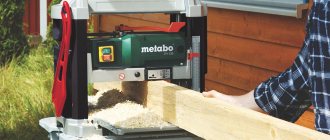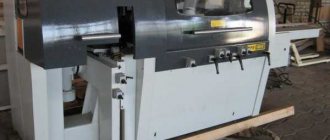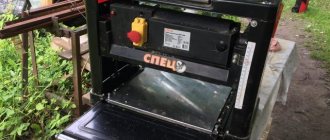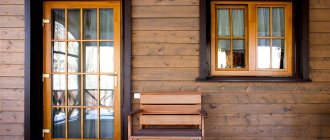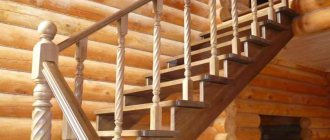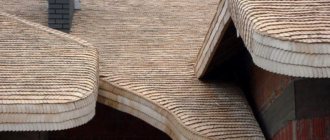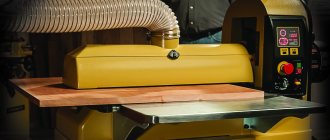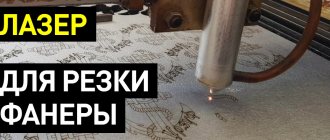One of the main operations when performing carpentry work is the alignment of the planes and edges of the workpiece. Planing (jointing) and thicknessing machines are used for this purpose. The former provide an even plane, the latter use it as a base to create a given thickness and parallelism of opposite edges or faces.
However, in a home workshop it is difficult to keep two machines at once. They are expensive, take up a lot of space, and require maintenance. The solution to the problem will be a planer-thicknesser machine that can provide both functions. Let's take a closer look at it.
What it is?
The cutting element of any wood planing machine is a knife shaft with 2, 3 or 4 knives. Its design is the same for any machine, jointer or surface planer. This made it possible to combine both functions in one unit, which is called a planer-thicknesser machine.
It works in two directions - from above it is a regular planer, but if you feed the workpiece from the opposite side under the work table, the unit works like a surface thicknesser. This design is compact and fully provides both functions. First, one plane (or edge) is processed, then it is fed from the opposite side with the processed surface down.
The broaching mechanism grabs the workpiece and passes it under the knife shaft, which removes chips to a given thickness. The ability to use one universal unit instead of two machines makes it possible to fully work in confined spaces. the quality of the surfaces meets all technical requirements corresponding to the class of the machine.
Why do we need thicknessing and jointing machines?
Among woodworking machines, the category of longitudinal milling machines stands out, which include jointers and thickness planers. With their help, you can process lumber for finishing. The machines remove all types of defects if they arise during wood processing.
For them, you need to take only wood that has been well dried. How do these types of tools differ from each other, and for what purposes is it best to use jointing machines, and for which thicknessing machines?
It is useful to read: what is moisture-resistant plywood.
For boards, panels and bars it is necessary to use thicknessing machines. They allow you to plan materials of a certain size, focusing on the desired thickness of the product and cutting it into two strips parallel to each other. They are very similar to CNC routers.
The knife shaft is located above the table. This group of tools is needed for serial or small-scale creation of various joinery products, when it is necessary to strictly observe the preservation of parameters. Their main distinguishing feature is their large and heavy rigid frame. This is necessary for high-quality damping of possible vibration.
The tools can feed workpieces at speeds from 4 to 10 meters per minute. Another important advantage of thicknessing machines is sound-absorbing casings, which make the work almost silent. Some types of machines are capable of processing only one side of the workpiece, so it will have to be turned over, others can plan the wood completely. Thicknessing machines can be double-sided or single-sided.
Planing machines for wood processing are necessary to create a smooth surface without a single roughness. They are equipped with a knife shaft, which wraps around the inside of the table. The tool can plan material at corners or along a plane. Machines of this type, like surface planers, can be single-sided or double-sided.
The latter are notable for the fact that they allow you to plan the edge and layer of the product at the same time. The functions of jointing machines include pre-processing of materials that have significant warping. Then the workpieces can be planed on a thickness planer.
Expert commentary
Ostakhov Alexey Mikhailovich
Practical experience, higher construction education. I talk about repairs and construction in clear language
Ask a Question
To check how well the parts are processed, you need to fold two pieces of wood. If they fit together like a glove, without a single gap, it means that the planing was done efficiently. A special shaft helps hold small parts during processing.
There is a mixed variety of machines, planer-thicknessers, which combine the advantages of both types of tools. Automatic feeding of workpieces to both types of machines is carried out thanks to three types of mechanisms: conveyor, carriage or roller. It is also possible to feed blanks manually.
READ Unusual Facts About the Bit
Machines must be maintained regularly. Before you start working on the machine, you need to check the condition of the cutters and knives to ensure they are installed correctly. If they become dull, they need to be sharpened. Otherwise, the product will develop unpleasant mossiness, chips and tears.
Wood processing.
Classification
There are different models of planer-thicknesser machines.
By purpose they are distinguished:
- Professional installations.
- Household models.
The difference between them is the power, body size and width of the workpiece being processed (working base). In addition, household and professional installations differ in price - household ones are much cheaper, but this does not prevent them from being fully functional devices.
Expert opinion
Levin Dmitry Konstantinovich
For use in a home workshop, household models are chosen. They are compact, do not take up much space, and operate on a regular 220 V network. Professional machines are used in industrial workshops. they are larger in size and require a three-phase voltage of 380 V for power supply. For household models, the housing is a supporting frame made of an angle or channel, covered with sheet metal. Professional machines have a cast iron body, which is heavy. it eliminates vibration and movement of the unit on the floor.
Options for making an electric plane
There are many ways to make a thickness planer using an electric planer. All of them are easy to manufacture and do not require the use of special tools. The most practical of them are:
- side planing thicknesser. Suitable for processing small planks and bars. This installation is easy to manufacture, and if necessary, the plane can be quickly dismantled and used for its intended purpose. The disadvantage is the need to constantly monitor the thickness of the treatment, since there are no pressure rollers;
- manual thickness planer. It has a more complex design and requires more time to manufacture. With its help, you can process boards and bars of greater length. In addition, the design uses pressure rollers, which minimize processing errors.
Design
The device of a planer-thicknesser machine is a frame or frame on which the hubs of the knife shaft are rigidly mounted. A movable work table with a mechanism for drawing the workpiece is installed under it. It is able to rise or fall to ensure the thickness of the part. When feeding a workpiece, the broaching mechanism picks it up and moves it under the knife shaft, which removes a layer of chips from the upper plane. Usually it is allowed to remove no more than 2-3 mm in one pass. Large professional machines sometimes have a tolerance of 5 mm.
A second table for jointing is installed along the upper generatrix of the knife shaft. The workpiece is fed in the opposite direction, towards the movement of the shaft. The back of the table is stationary, but the front can move up or down. This allows you to change the thickness of the removed layer. This feature is convenient when processing curved or screwed boards - the table is lowered to the maximum and the bottom surface is quickly brought to a flat plane. When it is necessary to remove a thin layer, the table is raised up and the chips are made to a minimum thickness.
The knives are replaced with the lower table completely lowered. The shaft is fixed in a stationary state, the clamping cone stops are loosened and the knife is removed. After sharpening, it is installed again, adjusting the position so that the cutting edge in a vertical position is exactly in the plane of the rear (fixed) table.
Making a thicknesser with your own hands
On the Internet you can find various designs for homemade jointers, which are distinguished by their functionality and ease of manufacture. Subsequently, you should adhere to the scheme on hand, selecting the appropriate components and correctly assembling the machine, the functionality of which will fully meet the requirements of homeowners.
Necessary materials
There are many options for making homemade planing machines, which will differ in their basis. The easiest way to make such a tool is using an electric planer or jigsaw.
To perform a surface planer you will need the following:
Electric planer.- Screwdrivers and keys.
- Ruler and corner.
- Screwdriver.
- Drive sprockets.
- Bicycle chain.
- Wooden beams and slats.
- A sheet of plywood 15 millimeters thick.
- Long threaded screws.
Plywood and timber will be required to make the base of the machine and the manual table, on which the electric planer and other elements responsible for the functionality and safety of using the equipment will subsequently be attached.
It is necessary to use high-quality wood, which is additionally recommended to be treated with impregnations against rotting.
Step-by-step instruction
Making a surface planer is not difficult, so almost anyone can handle this type of equipment.
The following work will need to be done:
- A sheet of plywood 15 millimeters thick is cut into a rectangle with a width of 400 millimeters and a length of 500 millimeters.
- In the middle of the rectangle, a mount-stand is made, to which the electric planer will subsequently be attached. The stand for the surface planer is made from a piece of plywood and is attached to the base with screws from the back side, which will ensure the strength and reliability of the machine made by yourself.
- A platform for an electric planer is being built. An opening is made in the platform, which is identical in size to the shape of an electric planer. The electrical appliance used is attached to the platform with screws and clamps.
- A drive mechanism is mounted on the base of the platform, which is responsible for raising and lowering the platform with the surface planer. Large-threaded screws are attached to the corners of the base. Subsequently, four sprockets are attached to the installed screws.
- Small stands are made from plywood, on which the platform with the upper part of the surface planer is installed. The stands are attached to the platform with screws or similar fasteners. It is necessary to think about the proper placement of the cable from the electric planer, which should be located at a short distance from the working saw of the planer.
- Fix the handle, which is intended to adjust the location of the platform. The easiest way is to fix the handle with a long screw with a large thread or secure it with several screws at once.
- At the final stage of work, an indicator and a measuring bar are installed.
- Using a measuring strip, you can measure the thickness of the processed lumber. It can be made from a small piece of plastic or wooden ruler. The indicator can be made from a pointer or a tin strip.
Criterias of choice
What jointing and thicknessing machine do you use?
HouseholdProfessional
The choice of planer-thicknesser machine is made according to several criteria:
- Power.
- Width of working base.
- Estimated load.
- Power supply type.
Depending on these requirements, a suitable machine model is selected. It must be taken into account that as needs increase, the price of equipment increases. Small household models cost about 20 thousand rubles, and professional units will cost 100, 200 or more thousand. In order not to spend extra money, you should soberly assess your needs and intended tasks.
If the machine is needed to perform small jobs and will be used only from time to time, you need to choose a model from the household group. For the production of large batches of parts on a continuous basis, professional equipment with the appropriate parameters is suitable.
The type of power supply available must be taken into account. Not all workshops have a three-phase network connection. In such cases, it is necessary to purchase equipment powered by 220 V.
Popular models
There are many types of planer-thicknesser machines on sale. They are able to perform different tasks and withstand the corresponding loads. Most often, they differ in the width of the working base and the power of the electric motor. The speed of rotation of the knife shaft and the power of the thicknesser drawing mechanism depend on it. Let's consider several models for professional and domestic use:
METABO HC 260 C DNB
German equipment has long been considered the standard of precision and quality. The machine has all the necessary devices for jointing a face or an edge, and is also capable of performing thicknessing without reconfiguring the upper table. The machine is installed on legs with roller supports, allowing it to be moved within the workshop if necessary. The dimensions of the unit are quite compact, but this does not affect performance or operating capabilities.
Specifications:
- Working base (maximum width of the workpiece when thicknessing) - 26 cm.
- The maximum chip thickness in one pass is 3 mm.
- The maximum thickness of the workpiece during thicknessing is 16 cm.
- The number of knives on the shaft is 2 pcs.
- Feed speed - 5 m/min.
- Electric motor type: single-phase asynchronous, powered from a 220 V network.
- The weight of the machine is 71 kg.
Judging by user reviews, the machine is reliable and accurate. Stably withstands the given thickness of workpieces, and during normal sharpening of knives it does not allow chips or torn areas. The owners note the complete correspondence between the price and capabilities of the unit.
Robland NXSD 410
The machine from a well-known Belgian company is designed for use in production workshops. It belongs to the category of professional equipment, which means increased strength and reliability of all components and parts. With a working base width of 41 cm, the length of the jointing table is almost 2 meters, which ensures high quality jointing of edges for gluing panels.
Machine characteristics:
- Working base - 410 mm.
- The length of the jointing table is 1985 mm.
- Planing depth (maximum) - 4 mm.
- The feed speed of the workpiece in the surface planer is 6 m/min.
- The number of knives on the shaft is 3 pcs.
- Workpiece thickness (maximum) - 23 cm.
- The rotation speed of the knife shaft is 5.5 thousand rpm.
- Power supply type - 3-phase 380 V.
- The weight of the machine is 320 kg.
Users note reliability, lack of vibration and high precision of jointing. The increased number of knives allows you to extend the interval between sharpenings, which gives a noticeable increase in productivity. The only drawback that all owners noted is the price - the machine costs about 300 thousand rubles, which is available only to specialized organizations.
BISON SRF-204-1500
The products of Russian manufacturers have long ceased to be second-class goods and compete quite successfully with Western analogues. Today, the Zubr company has transferred part of its production capacity to China, which has not affected the accuracy and reliability of the equipment. Planer-thicknesser Zubr SRF-204-1500 belongs to the category of household desktop type machines. It does not have its own stand, which makes the unit more compact, but requires installation on an appropriate support.
Unit characteristics:
- Working base - 204 mm.
- Workpiece thickness (max) - 120 mm.
- Planing depth - 2 mm (thicknesser), 3 mm (jointing).
- Workpiece feed speed - 8 m/min.
- The number of knives on the shaft is 2.
- Power supply type - single-phase, 220 V 50 Hz.
- The weight of the machine is 27.5 kg.
According to users, this is one of the best machines for the home craftsman. It is light and compact and does not take up space in the workshop. When work is completed, the machine can be put away on racks to make room for other tools. In addition, the affordable price is highly rated - about 18 thousand rubles.
BELMASH JT-2 254/120
Belarusian manufacturers offer a convenient and compact household-type planer-thicknesser machine. It is equipped with its own stand, but, if necessary, the unit can be installed on another suitable support. To reduce weight, most of the massive components (work tables, emphasis) are made of aluminum.
Characteristics:
- The working base of the machine is 254 mm.
- Planing depth - up to 2 mm.
- Workpiece thickness (maximum) - 120 mm.
- Feeding speed - 7 m/min.
- The number of knives on the shaft is 2 pcs.
- Electric motor - commutator, 220 V 50 Hz.
- Weight - 30 kg.
According to users, the machine fully complies with all the stated parameters and can be used in home workshops or in small-scale production. The disadvantage of the unit is that many users consider the price to be too high - about 27 thousand rubles.
ELITECH SFR 1525
Another representative of products from Russian manufacturers. The compact machine is equipped with its own stand, which relieves the user of the worry of creating a supporting structure. There is a pipe for connecting an aspiration unit that removes dust and chips. In addition, the unit is equipped with protection against reverse movement of the workpiece and has a protective strip above the knife shaft.
Characteristics:
- Working base - 254 mm.
- Workpiece thickness (max) - 120 mm.
- Planing depth - up to 3 mm.
- Feeding speed - 6 m/min.
- The number of knives on the shaft is 2 pcs.
- Supply voltage - 220 V 50 Hz.
- The weight of the machine is 36 kg.
User reviews are positive. Reliability and accuracy of planing are noted. At the same time, some owners doubt the durability of the chain drive, which requires regular lubrication and tension. In general, users are satisfied with the ratio of the quality of the machine and the price, which is about 20 thousand rubles.
JET JPT-8B-M 707400M
American manufacturers offer a universal type planer-thicknesser machine. It has compact dimensions, allowing the unit to be used both in a workshop and to be transported to the site. This is convenient when performing repair work, construction or finishing of buildings and premises.
Machine characteristics:
- Working base - 200 mm.
- The thickness of the workpiece is 120 mm.
- The maximum planing depth is 2 mm.
- The number of knives on the shaft is 2 pcs.
- Workpiece feed speed - 6 m/min.
- Power supply type - 220 V 50 Hz.
- Weight - 28 kg.
According to user reviews, the machine is only capable of performing simple tasks. Good for the home craftsman making crafts for the garden. Some owners consider it only suitable for teaching children, but others are quite satisfied with the quality and accuracy of the unit.
CALIBER SSR-1600
The Russian company Kalibr offers a household planer-thicknesser machine for use in home workshops or small-scale production. The unit shows high accuracy at a low price - it costs about 15 thousand rubles.
Characteristics:
- Working base - 204 mm.
- The thickness of the workpiece is 120 mm.
- The maximum planing depth is 3 mm.
- The number of knives on the shaft is 2 pcs.
- Workpiece feed speed - 6 m/min.
- Power supply type - 220 V 50 Hz.
- Weight - 24 kg.
According to user reviews, the machine is suitable for performing various tasks - planing, edge jointing, thickness calibration. Performs all operations with sufficient accuracy. A special feature of the machine is a magnetic starter, which prevents the machine from starting spontaneously after a power outage.
Basic Concepts
Such equipment will have numerous rotating parts. From this we can conclude that making such a machine with your own hands will not be so easy. Therefore, when starting to manufacture it, you need to calculate your strength. If you already have some similar experience, then you will cope with the task.
It is worth noting right away that you will not be able to make a jointing machine entirely from parts of your own making. Of course, it’s possible that you have a large assortment of different devices in your “bins,” but this rarely happens. First of all, this concerns the shaft with knives and bearings. They will most likely have to be purchased or even ordered. But if everything you need is available, then you can safely start designing.
Question to the expert
What will you need to assemble a thickness planer?
Some parts for the jointing machine: knife shaft, bearings, knives, you will have to buy or order. First of all, you should understand what kind of “package” you want to receive. There may be several options: just a jointing machine.
It will only perform one function; set of jointer and circular saw. In this case, the functionality of the machine is doubled; equipment capable of performing the role of a jointer, a circular saw, a grinding device, a grinding and drilling machine.
What is thicknessing?
Such a device will be very useful for your workshop, but it will be difficult to do it yourself. The most optimal and easiest option is to make a jointer and a circular saw on the same bed.
Material on the topic: what is mahogany and how to distinguish it from a fake.
Plus, both tools will rotate from the same electric motor. This feature will greatly facilitate our task. Let's look at the main components of our future tabletop jointing machine. It will include:
- Bed. This structure will support the entire machine and the equipment installed on it. To make it, it is best to use durable channels with a wall thickness of 8-10 millimeters. The bed can be made either collapsible or permanent. In the first case, all its components will be connected using bolts and nuts. If you do not need a portable machine, then the channels can be secured together by welding. This option will be more reliable. You can do without a bed if its role is played by a desktop;
- Work tool. This is one of the most important components of the machine. The jointer knives and the saw itself - it is with their help that you will saw and process the boards. The knives are firmly attached to the shaft. They must be made of reliable and strong steel. Circular saw with pobedit tips. Such a tool will last you much longer;
- Rotor. It is to this that all the tools will be attached. Without this part it is impossible to make a single machine, planer or circular saw. Finding a suitable rotor can be quite difficult, so it is better to order it from a professional turner, having previously provided it with drawings;
- Desktop. For a properly functioning machine, you need three surfaces. One will serve as a workbench for a circular saw, and the other two for a jointer. The thickness of the material for the working surface must be at least five millimeters. Multilayer plywood or metal sheets are suitable for these purposes. In this case, it is advisable to make a slight difference in height for surfaces intended for jointing. The side along which the workpiece will be fed should be a couple of millimeters lower than the side to which the already processed side will go. This difference will make work easier and significantly reduce vibration.
Structure of a thickness planer.
Types of machines
The Corvette planing thicknesser is a single system for planing and thicknessing processing. It has a powerful asynchronous motor, which is protected from overloads by means of a belt drive. In addition, it has a low noise level. If there is a temporary disconnection from the power supply, spontaneous start of operation is excluded due to the presence of a magnetic starter. Cast iron tables with a polished surface help reduce friction with the workpiece.
It is convenient to level the base surface of the workpieces, because the working and receiving tables have a fairly comfortable length. A quick transition from one mode to another is provided (thicknesser/planing and vice versa). For each of them there are two working positions at the nozzle. There is no vibration during operation.
Types of thicknessing machines.
The metabo surface planer also has a number of undeniable advantages:
- switch with rotary block;
- stationary reliable design with powder coating;
- tables made of cast iron with increased wear resistance;
- feed mechanism with the ability to turn off;
- a simple way to convert a thickness planer for jointing work; no tools are needed;
- high level of safety, including wood dust;
- presence of a drive handle for comfortable height adjustment;
- special knife with a double blade;
- improved processing quality;
- variety of configurations;
- durable body, stable, no vibration;
- rollers of optimal design;
- galvanic plating reliably protects shafts and screw connections from rust.
READ Compass in woodworking
Expert advice
When working on planer-thicknesser machines, it is necessary to strictly observe the safety requirements:
- Do not hold the workpiece over the rotating knife.
- Sleeves and other parts of clothing should not have hanging ends.
- The workplace should be well lit, but not with fluorescent lamps.
- During operation, be sure to use special pushers and other protective devices.
- The area near the machine should be free of wood scraps, blanks and other rubbish that would impede movement.
These requirements must be complied with without fail.
It is recommended to always work only with sharpened tools. If longitudinal grooves appear on the surface of the workpiece, it means that potholes have appeared on the cutting edge. This is a signal about the need to remove and sharpen knives.
In addition, you need to monitor the condition of the workpieces. Remove any nails or screws that may be embedded in them. It is not allowed to process wood stained with hardened cement mortar - this will quickly damage the knives. You should not try to remove a thick layer in one pass; you should be guided by the values set out in the technical characteristics of the machine. This will allow you to obtain high-quality processing of workpieces and extend the service life of the machine.
